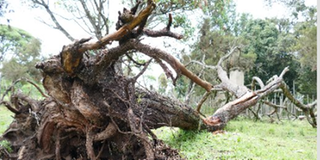Ogiek elders’ bylaws that protect Chepkitale Forest

A decaying Prunus tree at Chepkitale Forest in Mt Elgon, Bungoma County. The forest is one of the oldest protected forests in Kenya and is home to over 1,500 tree species
What you need to know:
- Chepkitale Forest is an enchanted place filled with the secrets of nature and the earth.
- Here, you'll find towering trees, both living and dead, that spread across the forest floor like gentle giants.
Chepkitale Forest in Mt Elgon is one of the oldest protected forests in Kenya and is home to over 1,500 tree species, including endangered species like Juniperus procera, Olea chrysophylla and Vachellia xanthophloea.
Numerous species of birds and animals such as the bateleur eagle, bushbuck and impala antelopes, can also be found in the forest. The elevation of the forest is around 1500m above sea level and it receives an average of 1300mm of rainfall each year.
Chepkitale Forest is an enchanted place filled with the secrets of nature and the earth. Here, you'll find towering trees, both living and dead, that spread across the forest floor like gentle giants.
As you wander through this enchanting landscape, you will come across fallen trees that are slowly decomposing. As you observe closely, you can see that mushrooms are thriving on these decaying trees, as if they are feeding off their remains. The forest is known for its chilly weather conditions.
Mt Elgon is an important natural resource in western Kenya's Bungoma County and serves as one of the big water towers that feeds water along the Nile basin all the way to Egypt.
“It is home to a wide variety of fauna and flora and provides livelihoods for thousands of residents. Despite this, the forest has been under threat due to illegal logging and other human activities.” Emmanuel Kimtai, a member of the Ogiek community, said.
The Ogiek community, with its generations-long roots in the area, have taken it upon themselves to protect the forest ecosystem. Johnstone Takur, chair of the Council of Elders, said: “We ensure that those who violate our traditional environmental protection laws understand the consequences."
Locals are not allowed to cut trees, even the fallen ones — they are left to decompose. "There are also bylaws which state that women are only allowed to collect firewood from the fallen trees, and for construction, only bamboo trees are used,” said Takur
Trees are especially valuable to the community. Kimtai noted that they provide food, medicinal products, production of honey, and prevent soil erosion. Moreover, charcoal burning is prohibited as it scares away bees from the area.
According to an article that analysed trends in land cover by the Kenya Forestry Service, there has been an 18 per cent decline in natural forest cover, a 15.19 per cent decline in bamboo forest cover between 1977 and 2019, and a 15.6 per cent decline in forest cover planted from the 1990s onwards.
Despite these statistics, the Ogiek community's efforts have helped to preserve the forests’ ecosystem as well as their culture. The community is sensitised on sustainable utilisation of eco-services and introducing alternative incomes like bee-farming and wild animal conservation. George Wara, Bungoma County Forest Conservator, applauded the Ogiek council elders for forming traditional bylaws that have helped conserve the environment. The conservator said Mt Elgon Forest sits on 50,500 hectares of land, 17,000 of which is part of Chepkitale area.
Wara noted that the bylaws set by the Ogiek council of elders are a very elaborate system to conserve the ecosystem. Initially, the government had evicted Ogieks from the forest. But the order was overturned last year, allowing the Ogiek to settle back in the forest.
“These bylaws have really helped us conserve the forest on the upper side of the mountain, they are a very elaborate system of environmental conservation, if you go there you find indigenous trees that fell many years ago and no one is harvesting them,” Wara said.
The Ogiek elders’ traditional bylaws have thus succeeded in protecting Chepkitale Forest, and maintaining the balance between its cocoon of biodiversity and the livelihoods of the Ogiek people.
Wara pointed out that Ogiek has protected the forest better than many other communities that look at forests exclusively as economic resources, thereby engaging in destructive activities such as logging and charcoal burning.





